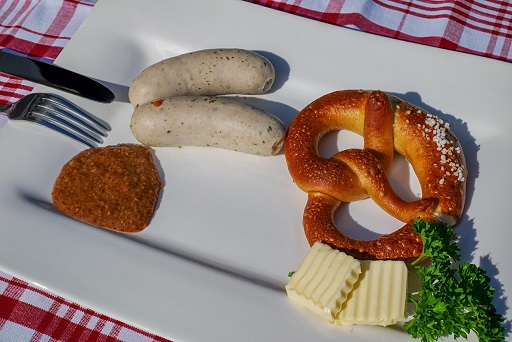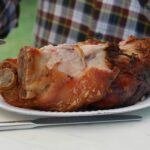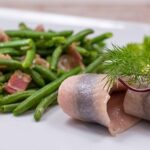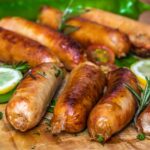
Traditional German food is far more than sausages and sauerkraut. It is a mosaic of regional flavors, seasonal ingredients, and deeply rooted cultural practices. Each dish tells a story – of harvests and holidays, of resilience and hospitality, and of a nation that eats with intention. Whether you’re savoring pork knuckle in Munich, smoked fish in Hamburg, or a slice of Black Forest cake in Baden-Württemberg, you’re tasting the traditions that shape everyday life in Germany.
This guide takes you on a culinary journey through Germany’s food culture – exploring its regional specialties, essential ingredients, cultural rituals, and the values behind the meals. We’ll also link you to in-depth articles on Bavaria, Northern Germany, bread culture, and seasonal traditions, giving you the complete flavor profile of this extraordinary cuisine.
➡️ Related:
- Bavarian Cuisine: Pretzels, Pork, and Beer Culture
- Northern German Dishes: Herring, Kale, and Maritime Flavors
- German Bread Culture: Why It’s UNESCO-Recognized
- Seasonal German Foods: From Asparagus to Christmas Goose
What Makes German Food Unique?
German food is defined by comfort, tradition, and locality. Most dishes are hearty and filling, often centered around meat, potatoes, or bread. But it’s not a cuisine of excess – it values balance, structure, and seasonality. German meals are often simple but precise, with sauces and spices carefully curated to match the ingredients.
Key characteristics:
- Local sourcing: Most traditional dishes are built around regional crops and livestock.
- Preservation methods: Pickling, smoking, and curing are central techniques.
- Structured meals: Breakfast (Frühstück), lunch (Mittagessen), and dinner (Abendessen) are clearly defined with little snacking in between.
- Cultural formality: Meals are communal and often tied to family or holiday rituals.
The Regional Food Map of Germany
Germany’s federal structure and diverse landscapes mean food can vary dramatically from one state to the next. Here’s a snapshot of the most distinct regional traditions:
Bavaria (Bayern): Known for its beer culture, white sausages (Weißwurst), giant pretzels (Brezn), pork knuckle (Schweinshaxe), and sweet mustard. Meals are hearty, beer-accompanied, and often communal in beer gardens.
Swabia (Schwaben – part of Baden-Württemberg): Famous for egg noodles like Spätzle, cheese dishes like Käsespätzle, and Maultaschen (stuffed pasta).
The Rhineland: Features Sauerbraten (marinated beef roast), Reibekuchen (potato pancakes), and regional wines, especially Riesling.
Northern Germany: Dominated by seafood like pickled herring (Rollmops), smoked eel, and kale dishes such as Grünkohl mit Pinkel. Bread culture is exceptionally strong here.
Saxony and Thuringia (East): Known for Thuringian bratwurst, Sauerbraten with red cabbage, and pastries like Dresdner Stollen.
Franconia (Franken): Offers hearty pork dishes, dumplings, and distinctive Franconian beer styles.
➡️ In-depth: Northern German Dishes: Herring, Kale, and Maritime Flavors
Essential German Ingredients
You’ll find these ingredients in kitchens across the country:
- Cabbage: Both fresh and fermented (Sauerkraut)
- Potatoes: Mashed, boiled, fried, or in dumplings (Knödel)
- Pork: Especially in sausages, roasts, and stews
- Vinegar: Used in salads, sauces, and pickling
- Caraway, marjoram, mustard, dill: Common herbs and spices
- Bread flour: Rye and spelt are widely used for dark, dense loaves
While Germany may not be famous for bold spices, its use of herbs and fermentation gives its dishes a complex, savory depth.
Mealtime Structure and Etiquette
Traditional German meals follow a predictable rhythm:
- Breakfast (Frühstück): A light but structured meal – bread, butter, cheese, cold cuts, and coffee
- Lunch (Mittagessen): The main hot meal, typically meat and potatoes or pasta
- Afternoon Coffee (Kaffeezeit): A social pause for cake and coffee
- Dinner (Abendbrot): Cold meats, cheeses, pickles, and dark bread
Etiquette still matters:
- Say “Guten Appetit” before eating
- Keep both hands visible on the table
- Toast with eye contact (“Prost!”)
- Don’t start before the host
Germany’s Bread Culture
No conversation about German food is complete without bread. Germany has over 300 types of bread and 1,200 varieties of rolls – more than any other country. Bread is integral to every meal and baked fresh daily by local artisans.
Popular varieties include:
- Roggenbrot: Dense rye bread
- Vollkornbrot: Whole-grain bread
- Brötchen: Crispy white rolls
- Laugenbrötchen: Pretzel rolls
Bread even has its own mealtime – Abendbrot (“evening bread”) – consisting of slices served with butter, meats, and pickles.
➡️ Deep dive: German Bread Culture: Why It’s UNESCO-Recognized
Sausages and Meats: The German Butcher’s Art
Germany has over 1,500 varieties of Wurst (sausage) – each region has its favorite:
- Bratwurst: Grilled pork sausage from Thuringia and Franconia
- Weißwurst: White veal sausage from Bavaria
- Currywurst: Iconic Berlin street food topped with ketchup and curry powder
- Leberwurst: Liver sausage spread on rye bread
Pork roasts (like Schweinebraten), schnitzel, and beef dishes such as Sauerbraten round out the meat menu.
Vegetables and Sides: Comfort with a Tang
German side dishes are robust and often tangy:
- Sauerkraut: Fermented cabbage – a staple with pork
- Rotkohl: Sweet-sour red cabbage
- Kartoffelsalat: Potato salad (vinegar-based in the north, mayo-based in the south)
- Knödel or Klöße: Potato or bread dumplings
These sides balance out the richness of meats and bring texture and acidity to the plate.
Desserts and Cakes: Layered Indulgence
Germans are serious about their cakes and desserts:
- Schwarzwälder Kirschtorte (Black Forest Cake): Chocolate, cherries, and cream
- Bienenstich: Yeast cake with custard filling and almond topping
- Stollen: Fruit bread baked during Christmas
- Pflaumenkuchen: Plum cake, popular in autumn
Bakeries (Bäckereien) are everywhere – and an afternoon coffee and cake is a cherished ritual.
➡️ Explore more: Seasonal German Foods: From Asparagus to Christmas Goose
Drinks: More Than Just Beer
Beer is iconic, but not the whole story:
- Pilsner: Light, hoppy lager from the north
- Hefeweizen: Yeasty wheat beer from Bavaria
- Kölsch: Crisp ale from Cologne
- Apfelschorle: Apple juice with sparkling water
- Schnapps and Obstler: Fruit brandies
- Glühwein: Hot spiced wine during winter markets
Wine is also major in the Rhineland and Franconia – especially Riesling and Silvaner.
Food as Identity
Traditional German food reflects:
- Regional pride: Locals are fiercely loyal to their state’s cuisine
- Social ritual: Meals are shared, structured, and slow
- Seasonal awareness: Germans embrace eating with the calendar
- Resilience: Pickled, preserved, and hearty foods emerged from necessity and became comfort
Traditional German food isn’t flashy, but it’s rich in meaning, history, and variety. Whether you’re enjoying Spätzle in the Alps or smoked fish on the coast, you’re experiencing a culture that values flavor, form, and family.







